 “His face, which appears like a spotless moon,
“His face, which appears like a spotless moon,
is illuminated by a splendorous shining crown of jewels.
He wears two earrings which resemble the planets
Jupiter and Venus as they rise in the evening sky.
Such is Sri Rama, Guru of the three worlds, whom I eternally adore.”
(Sri Ramastakam by Sri Murari Gupta)
vitarasi diksu rane dik-pati-kamaniyam
dasa-mukha-mauli-balim ramaniyam
keasava dhrta-rama-sarira jaya jagadisa hare
“Oh, Kesava! Oh, Lord of the universe! Oh, Lord Hari, who has assumed the form of Ramachandra! All glories to you! In the battle of Lanka You destroy the ten-headed demon Ravana and distribute his heads as a delightful offering to the presiding deities of the ten directions, headed by Indra. This action was long desired by all of them, who were much harassed by this monster.”
(Sri Dasavatar-stotram (7) by Srila Jayadeva Goswami)
Like The Waves of a River
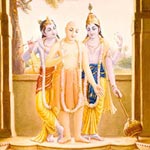
Sri Chaitanya Mahaprabhu appeared in previous ages as Lord Krishna and Lord Ramachandra
Srila Bhakti Raksak Sridhar Dev-Goswami Maharaj often spoke of the glories of Sri Rama and in a recorded conversation with His Divine Grace, published in the Centenary Anthology, he noted, “I was born at midnight, Saturday 10th October, 1895. Navami tithi (lunar day) under the same sign as Lord Ramachandra. Krishna-paksa (dark moon fortnight). Sriman Mahaprabhu was also born on a Saturday. I was the second child. The first was a daughter, but she died early, so Ram Kavach (a protective mantram and amulet) was given to my mother for the protection of the next child, that is, myself. So I was born after my mother took Ram Kavach… When I was in my maternal uncle’s house, for three years for early education in a primary school, I got some help from one of my aunts who taught me Ramayana and Mahabharata. That helped me a great deal… I like sacrifice in life. The magnanimous side. I had affinity for Lord Ramachandra… My attraction to Krishna first came through Bhagavad-Gita, and then through Mahaprabhu. I liked Ramachandra for His magnanimity. I was mainly attracted by the self-giving ideal.”

Srila Govinda Maharaj in Russia with Srila Janardan Maharaj and Srila Acharya Maharaj
Srila Bhakti Sundar Govinda Dev-Goswami Maharaj also spoke lovingly of the pastimes of Sri Ramachandra. After viewing the devotees’ re-enactment of the Ramayana during his visit to Russia, he said, “The whole of India is enlightened by the divine pastimes of Ramachandra, the Supreme Personality of Godhead appearing in Treta-yuga.”
ramadi murtinu kala-niyamena tisthan
nanavataram akarod bhuvanenu kintu
kanna svayam samabhavat parama puman yo
govindam adi-purusam tam aham bhajami
(Sri Brahma Samhita: 5.39)
Srila A.C. Bhaktivedanta Swami Maharaj has said, “This is a verse from Sri Brahma-samhita in which the incarnation of Lord Ramacandra is described. Ramadi. Not only Rama, but there are many other, innumerable incarnations. They are compared with the waves of a river. As the waves of the river, or the waves of the ocean cannot be counted, similarly, how many incarnations are there of the Supreme Lord it is not possible to count. But out of them, the principal names are mentioned in the sastras. Therefore it is said ramadi. Ramadi means Rama and also other, many incarnations. They are always existing.”
To Protect My Devotees
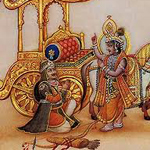
Sri Krishna reveals to Arjuna: "Whenever there is a decline in religion, I personally come Myself to restore the tradition of the Vedas and to protect My devotees.”
Sri Krishna says in the Bhagavad-gita that “whenever there is a decline in religion, I personally come Myself to restore the tradition of the Vedas and to protect My devotees.” Lord Rama is the powerful and noble incarnation of Krishna that appeared in Ayodhya during the Treta Yuga. According to the Vedas, the universe is constantly created and destroyed and each creation is divided in to four yugas, or time periods; Satya Yuga, Treta Yuga, Dvapara Yuga, and the present age of Kali Yuga. Lord Rama performed many glorious pastimes during His time on earth and many love to hear of the heroic pastime in which He conquered the demon Ravana, who had abducted His wife Sita. Lord Ramachandra’s righteous pastimes are beautifully told in the Ramayana by Maharishi Valmiki, who was instructed to write the Ramayana by his spiritual master Narada Muni.
Most of the ancient Puranas including the Mahabharata and the Srimad Bhagavatam (Bhagavata Purana) also give accounts of Lord Rama’s life. About five hundred years ago, Sri Tulsidas wrote about the pastimes of Lord Rama in a lovely and sweet poetic style in his Ramacharitamanasa. Some refer to his writing as the Tulsi Ramayana. In this beautiful work, Tulsidas references all the stories of Lord Rama contained in various Vedic literatures including the Valmiki Ramayana and the Brahmananda Purana. Because he relates the story of the Ramayana in a mood of deep devotion and love, it is cherished and honored by the devotees.
Rama-rajya
Lord Ramachandra exemplifies the role of a perfect human being. He was an ideal son, husband, friend, and king. The ninth canto of Srimad-Bhagavatam reveals that Sri Rama was a saintly king and that everything in his character was good, untinged by qualities like anger. By example, He taught noble behavior for everyone, and especially for householders, in terms of varnasrama-dharma. The kingdom of Lord Ramachandra is referred to as Rama-rajya—a kingdom of good government where everyone is happy. People are very fond of the pattern of Rama-rajya, and even today politicians sometimes form a party called Rama-rajya, but unfortunately they have no obedience to Lord Rama. It is sometimes said that people want the kingdom of God without God. Such an aspiration, however, cannot be fulfilled. Good government can exist when the relationship between the citizens and the government is like that exemplified by Lord Ramachandra and His citizens.
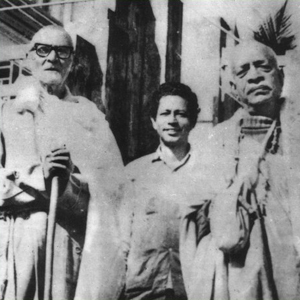
Srila Sridhar Maharaj, Srila Govinda Maharaj and Srila Prabhupad
Srila Bhaktivedanta Swami Maharaj has shown how the Srimad-Bhagavatam teaches that, historically, the king was responsible even for severe cold or severe heat. “The kings were so much responsible. They were always thinking of the happiness of the citizens, and the citizens were also so nice. There is no difference between the Lord’s form, His name, His pastimes, and Himself. He is absolute. Therefore if you chant the holy name of Rama or you see the form of Rama or you talk of His transcendental pastimes, everything, that means you are associating with the Supreme Personality of Godhead. So we take advantage of these days when the incarnation of God appears or disappears, and we try to associate with Him. By His association we become purified. Our process is purification. Krishna consciousness means simply we are purifying our consciousness. To make successful the human life or the mission of human life, the Vedic culture is very nice. And by spreading Krishna consciousness, by adopting the process of Krishna consciousness, you can revive that cultural life, sublime life.”
The Devotional Aspect
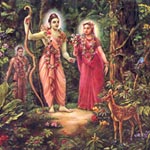
Lord Rama with Sita Devi and Laksman in the forest
Lord Ramachandra is worshiped along with His wife Sita, younger brother Laksman, and His greatest devotee Hanuman.
premnanuvrttya silena
prasrayavanata sati
bhiya hriya ca bhava-jna
bhartuh sitaharan manah
(Srimad-Bhagavatam: 9.10.55)
“Sita was submissive, faithful, shy and chaste, always understanding the attitude of her husband. Thus by her character and her love and service she completely attracted the mind of the Lord”.
Srila B. R. Sridhar Dev-Goswami Maharaj told how gradually the idea came to him that “the feminine ego-conception is an ideal of a very noble type wherein sacrifice, the devotional aspect, is very prominent. He gave the example of Sita, Draupadi, and many others, especially the supreme example of the Gopis. The standard established by the Gopis has shown that self-forgetfulness, self-sacrifice, and self-surrendering reaches its zenith, its highest conception, in the lady aspect. The passive aspect holds the highest position: that viewpoint came gradually and caused a turnabout within my mind.” In Sri Sita Devi we also find this highest conception of devotional purity.
“I always offer my humble service to the beautiful lotus feet of Sri Ramachandra, the Guru of the three worlds at whose left side is Sri Sita Devi with Her divine brilliance and hue of molten gold. She is holding the lotus by Her supine with Her five fingers. In this way, the lotus appears as if it has five more petals.”
(Sri Ramastakam by Sri Murari Gupta)
Exalted and Dignified Position
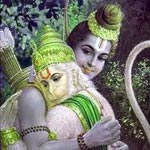
Lord Rama and His eternal devotee Hanuman
ram rasayan tumhare pasa
sadaa raho raghupati ke dasa
(Hanuman Chalisa)
“Oh, Hanumanji! You hold the essence of devotion to Ram, always remaining His servant.”
In his Brhad Bhagavatamrita, Srila Sanatan Goswami upholds Hanuman as the perfection of dasya-rasa, or servitude. Hanuman is the devotee, the servant of God, to the highest degree.
Within this mundane world the idea of servitude, of slavery, is a detestable prospect. But in the spiritual realm, and in the practice of sincere spiritual aspirants, wholesale surrender and slavery to the Supreme is acknowledged as the most exalted and dignified position. It is unfathomable, but it is our highest ideal. Our highest jewel. It is not a cheap thing, but rather, our capacity to offer ourselves fully, to realize our negative character, that ideal is our most precious gem. And if we can find that position in which “we will always be with folded palms, and where we can never be master,” then the higher Authority must have mercy and must extend down to our level to offer gracious help. When we hear the qualities of the perfect servant of the Lord, we remember Sri Hanuman.
Blessed Lord and Master
In Chaitanya Mahaprabhu’s lila, Hanuman appears as a physician named Murari Gupta. Srila B. R. Sridhar Maharaj has said, “Mahaprabhu tried to convert Murari Gupta, but He could not. Then he left. His strong inclination was towards Ramachandra. But still, Murari Gupta had some respect for this. Then, also, perhaps Rupa Goswami and Sanatana tried their best to take the father of Jiva Goswami, Anupama – he was a devotee of Ramachandra – to take him to krsna-lila, but they also failed. So, they tried, and that has got some value, even by Mahaprabhu and Sanatana, that is not a chance coincidence or a flickering or false attempt. So it is possible, and at the same time, there is such a strong and innate nature, that cannot be converted. That faith, that thing, is in the jiva.” Mahaprabhu tested Murari Gupta’s devotion and ultimately glorified him for his exclusive devotion to Lord Ramachandra. The Lord said to him, “For my pleasure, please recite that verse you composed.” Murari Gupta cited his book Sri Krishna Chaitanya-charita:
“I worship the blessed Lord and Master of the three worlds, Sri Ramachandra. He wears a brilliant crown covered with a strand of jewels with shining lights in all directions. His dazzling earrings defeat the brilliance of Sukra and Brhaspati. His beautiful face looks like a pure spotless moon.
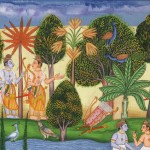
Lord Rama And Laksman
“I worship the lotus feet of the master of the three worlds, Sri Ramachandra, whose charming eyes appear like blossoming lotus flowers. His red lips look like bimba fruits, and His well-shaped nose attracts everyone. His wonderful smile embarrasses the moonlight.”
After hearing these verses, Sri Gaurahari put His feet on Murari’s head. Then He wrote the name “Ramadasa” on his forehead and said, “Murari, from today on, by My mercy, you’ll be known as Ramadasa. Without Raghunatha, you cannot live a moment. Know for certain that I am the same Lord Raghunatha (Rama).”
Sri Rama is so compassionate and merciful. In Sri Sri Prapanna-jivanamritam, Srila Bhakti Raksak Sridhar Dev-Goswami Maharaj writes, “If one seeks refuge in Him just once, He awards fearlessness to the person forever,” and quotes a verse from the Ramayana:
sakrd eva prapanno yas tavasmiti cha yachate
abhayam sarvada tasmai, dadamy etad vratam mama
(Sri Sri Prapanna-jivanamritam: 9.4)
“It is my pledge that if anyone just once sincerely petitions Me for shelter, saying, ‘I am Yours,’ then I grant him courage for all time to come.”
~~~~~~~~
Lord Ramachandra’s spotless name and fame, which vanquish all sinful reactions, are celebrated in all directions, like the ornamental cloth of the victorious elephant that conquers all directions. Great saintly persons like Markandeya Rishi still glorify His characteristics in the assemblies of great emperors like Maharaja Yudhishthira. Similarly, all the saintly kings and all the demigods, including Lord Shiva and Lord Brahma, worship the Lord by bowing down with their helmets. Let me offer my obeisances unto His lotus feet.
(Srimad-Bhagavatam: 9.11.21)
Armed with a bow and arrow and accompanied by Your younger brother and Janaka’s daughter, O Lord Sri Rama, pray dwell forever like a moon in the firmament of my heart.
(Sri Ramacharitamanasa)
~~~~~~~~
